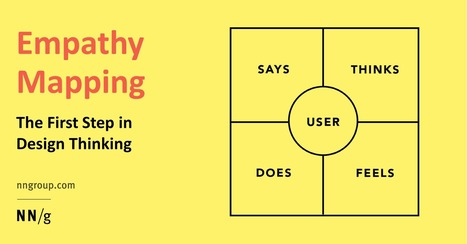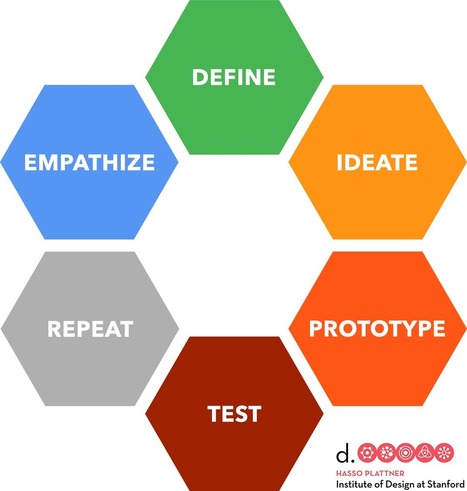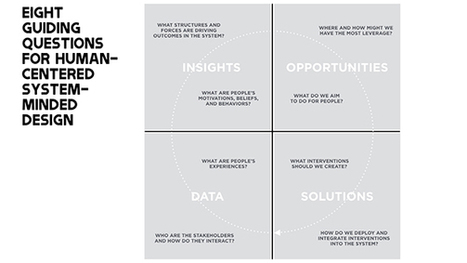 Your new post is loading...
 Your new post is loading...
The Five Stages of Design Thinking
The design thinking process covers five phases: empathize, define, ideate, prototype, test. The framework is iterative, flexible, and involves the collaboration of product teams and actual customers to create mobile products inspired by how users think, feel, and act.
1. The Empathize Stage
Building customer empathy involves a deep understanding of the problems and realities of the people you are designing for.
Good UX design leaves a lasting impression. Many companies struggle when it comes to developing an MVP that evokes meaning and forms a connection with customers. Many products in the market are aesthetically pleasing and usable but still lack purpose. It’s essential to determine what impression the product is leaving with its users. This distinction is the difference between an app that customers return to and one they uninstall. Empathizing with customers is essential for creating this connection. As much as possible, business stakeholders need to step outside their frame of reference and understand the customer to develop a mobile solution that stands out in the market.
Via Edwin Rutsch
At SAP, we practice this type of work every day. It is one of our foundational pillars and it underpins who we are as a company. While the sports fan in me likes to refer to it as game planning, the business leader in me calls it design thinking. Similar to how a coach prepares strategies for his or her team to overcome unforeseen challenges in a sporting event, design thinkers actively reimagine business models, business processes, and the way companies work to outperform digital disruption.
“Design thinking empowers us to redefine business problems through empathy and creativity”
Design thinking is essentially a human-centered and empathetic approach to innovation that integrates the needs of people, the possibilities of technology, and the requirements for business success. It breaks boundaries for businesses by rethinking current problems and developing entirely new capabilities. March 6, 2018
by Lloyd Adams
Via Edwin Rutsch
Process: How to Build an Empathy Map
Go through the following steps to create a valid and useful empathy map:
1. Define scope and goals
a. What user or persona will you map?
Will you map a persona or an individual user? Always start with a 1:1 mapping (1 user/persona per empathy map). This means that, if you have multiple personas, there should be an empathy map for each.
b. Define your primary purpose for empathy mapping.
Is it to align the team on your user? If so, be sure everyone is present during the empathy-mapping activity. Is it to analyze an interview transcript? If so, set a clear scope and timebox your effort to ensure you have time to map multiple user interviews.
Via Edwin Rutsch
Design thinking is an empathy based, creative problem solving process embraced by innovators around the world for addressing complex problems. At its heart, it nurtures the ability to see a situation from someone else's point of view, engineer a solution, and then test and refine your solution based on feedback. It is one approach CSI students will use to master the California Common Core State Standards and build the adaptable thinking skills they will need for success in the 21st century workforce.
Via Edwin Rutsch, june holley
In Argentina, as in the US, the old journalism model is decaying. In the US, nonprofit journalism has become increasingly prominent; in Argentina, building on that nation’s strong worker co-op sector, journalists themselves are becoming owners of their own publications.
Via june holley
This is a resource for anyone who wants to do things more creatively and collaboratively in their team or organization. It’s a collection of methods and activities, based on Hyper Island’s methodology, that you can start using today.
Via june holley
Aperture and Paris Photo announce the shortlist for the 2016 PhotoBook Awards.
Japanese retailer Muji is holding an exhibition of 25 archival advertising posters designed by Ikko Tanaka. The collection of prints will be on display in London’s Covent Garden from 18 – 23 October, and in Milan from 27 October – 7 November, celebrating 25 years of Muji in Europe.
Jean Martin’s documentary Peter Vogel: The Sound of Shadows is a lasting document complementing the artist’s first solo exhibition in Britain. It provides viewers with a rich context to understand the artist and his works, whether or not they were able to visit the exhibition itself. The film offered an appropriately dynamic medium to explore and reflect on Vogel’s time-based, interactive objects, yet nobody anywhere in the world had previously made a full-length documentary about Vogel. Due to the artist’s age and health, it was imperative to take the opportunity to complement the exhibition premiere of his sonic interactive sculptures at the University of Brighton in 2011 with a comprehensive DVD.
Two prime research questions emerged: how best to demonstrate the ways in which time-based, interactive sound objects work; and what made Peter Vogel’s work pioneering and different? Over the two-year evolution of this project, Martin’s method included filming Vogel in his Freiburg studio and elsewhere (including his solo exhibition in Paris, 2009) as he talked about what motivated him to create his interactive, dynamic works, given that he started out as a painter. Closely allied to this, Martin filmed examples of Vogel’s artworks in action, with the artist explaining his creative and technical approaches. Martin examined the context in which Vogel worked and his role in sound art history through an interview with Professor De La Motte, a leading German academic in the field. He explored aspects of sound theory and philosophy, including the roles played by interaction, chance and causality, and the practice (which can be termed the ‘aestheticisation of technology’) of showing the electronic circuitry in the artworks themselves. In addition to the DVD, a comprehensive website devoted to Vogel’s work includes exhibition details, published essays and examination of key works.
Via Jacques Urbanska
Depuis 25 ans l’artiste Daniel Ranalli crée des oeuvres en rapport avec la nature, dans cette série « Snail Drawings » il place des escargots sur le sable humide d’une plage de façon ordonné et les laisse ensuite se déplacer naturellement, laissant derrière eux des motifs composés de la trace de de leur passage sur le sable …
For its 5th edition, the BOZAR Electronic Arts Festival will once again showcase a series of international artists that represent the state of digital culture today. A vast line up of musicians and producers, ranging from cutting edge experimentalists to high profile electronic acts will perform in various adapted venues. During 10 days, you will experience audio-visual installations and performances reflecting on the current dialogue between the use of new technologies and strong artistic personalities . And much more... Pour sa 5e édition, le BOZAR Electronic Arts Festival présente cette année encore des artistes internationaux à la pointe de la culture numérique. De nombreux musiciens et producteurs parmi lesquels de grandes figures de l’électronique actuelle, se produiront dans les différentes salles du Palais. Durant 10 jours, BEAF vous propose des installations audiovisuelles et des performances qui reflètent l'état actuel de l'utilisation des nouvelles technologies. Et bien plus encore ! Tendencies artists : Elias Heuninck
Jerry Galle
Dries Depoorter
Sébastian Lacomblez
Félix Luque & Damien Gernay
Frederik De Wilde With the support of the Fédération Wallonie-Bruxelles
Via Jacques Urbanska
Harmony Korine is the writer / director of Gummo (1997), julien donkey-boy (1999), Mister Lonely (2007) and Trash Humpers (2009). He is also the witer of the Larry Clark films Kids (1995) and Ken Park (2002).
Customers with positive associations with a brand will spend up to 200% more and will also tell an average of eight friends about them.
Via Eric_Determined / Eric Silverstein
|
1. There is a “back-to-basics” focus on the fundamental mindsets and skills of design thinking.
I‘ve observed a growing demand from both nonprofit and for-profit organizations for support and training around the fundamentals, such as active listening skills and empathy-building methods.
While more and more employees have been exposed to the overall design thinking process, there is a sense that some of the essentials have been neglected.
This to me represents a sophisticated understanding of the design thinking framework, as a good design thinker is only as good as their foundational skills.
In addition to active listening and empathy-building, other fundamentals include comfort with ambiguity, a bias to action, group facilitation skills, and an ability to mindfully separate convergent from divergent activities.
Via Edwin Rutsch
It is time for business leaders to understand the power of design and design thinking; specifically how Design Thinking will help them transform their businesses and make them future-proof Walk a mile in my boots
Empathise, empathise and empathise some more! This is the foundation design thinking is built on. We need to “walk” in our customers’ shoes to be able to fully experience the world from their perspective. Without true empathy, we won’t be able to identify the “real” problem and in turn deliver game-changing outcomes. We need to know why – why is a certain product more popular than the other? Why do people choose a particular cab service over the other? With each answer, we need to dig further until we know the real reason why! Only when we can see, think and feel the way our customers do, will we be able to determine what would be game changing for them. Empathy is the bedrock of meaningful and memorable products, services and experiences.
Via Edwin Rutsch
In fact, there are a number of different approaches or terms within this broad heading, such as experiential learning, co-operative learning, adventure learning and apprenticeship. I will use the term ‘experiential learning’ as a broad umbrella term to cover this wide variety of approaches to learning by doing.
Via Edumorfosis, juandoming, june holley
Both human-centered and systems-thinking methods fit within an effective design approach, and can work in conjunction to address social challenges.
Via Steve Wilhite, june holley
The issues we tackle are complex, big and important. They create debate and are subject to scrutiny from scientists, government and big business, as well as individuals. But whatever the reason, if we want to create large-scale behavior change and truly engage people in sustainability, we are going to have to cut through this complexity. We must simplify, create clarity, and make it easy and convenient for people to opt into sustainability. Otherwise, nothing will ever change.
Via june holley
Its terms are so specialized and vague they're only useful to those in the know.
Via Xaos
Design is not art. It’s a distinction understood by practicing designers, but it still eludes many. In an Oct. 29 talk at the Guggenheim Museum in New York City, the 87-year-old graphic design legend Milton Glaser gave the best definition of the practice of design. “Design is the process of going from an existing condition to a preferred one,” said the 2010 National Medal of Arts recipient. “Observe that there’s no relationship to art.”
When I was just starting out in 1992 to create interactive, or reactive as I dubbed them, graphics, there was a great deal of CD-ROM-based content emerging that seemed to miss the point of computational media. With the digital media publisher Digitalogue, I created 4 books (the 5th never made it to print) that focused upon different aspects of the computer as related to the visual medium. maedastudio.com/2004/rbooks2k/index.php?this=reactive_books
Via Jacques Urbanska
In 2008 Florian ‘Doc’ Kaps helped save the Polaroid photographic medium from oblivion with the Impossible Project, an initiative that reversed engineered the much-loved technology and put the film back into production. The history of Polaroid, and the efforts to save it, are documented in a new book written by Florian. Polaroid – The Magic Material is published by Frances Lincoln and is available on 10 November. Here, we publish an extract telling the story behind Edwin Land’s inspiration for inventing the technology.
Max Yakin Bozek's vimeo profile
Pour sa programmation 2017, DAÏMÔN souhaite soutenir des projets qui proposent une exploration novatrice de la narrativité en arts médiatiques. Nous sommes à la recherche de projets qui interrogent les nouvelles formes de mise en récit et de discours narratifs à l’ère du numérique. L'appel complet peut être consulté ici:
http://www.daimon.qc.ca/event.php?lg=fr&id=33 DEADLINE 01.09.2016 For its 2017 programming, DAÏMÔN wishes to receive submissions which propose innovative explorations of narrative in media art. We are seeking projects which interrogate new ways of making narrative and creating meaning in the digital era. All the details here:
http://www.daimon.qc.ca/event.php?lg=en&id=33
Via Jacques Urbanska
|



 Your new post is loading...
Your new post is loading...





























